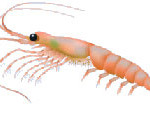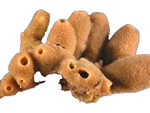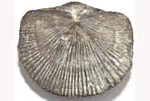
In spite of there being a large number of living species – around 5000 – bryozoa remain relatively unknown. The name literally means ‘moss animals’, after the bushy, moss-like appearance of some species. The two main types are encrusting bryozoans and erect bryozoans.
These aquatic – principally marine – animals exist for the most part as colonies of interconnected individuals called zooids. Colonies may consist of just a few zooids, or many millions. Some species encrust rocky surfaces, shells and algae. Other species form lacy or fan-like colonies. Individual zooids are rarely larger than a millimetre, but colonies can range in size from just a few millimetres to several metres.
Because of the colony forming nature of bryozoans, and because they are highly varied in both form and shape, they are sometimes confused with corals, hydrozoans and even seaweeds and sponges. Bryozoan colony structures and forms range from creeping colonies consisting of series of zooids arising from encrusting stolons (a stem like structure of colonial organisms from which new individuals arise by budding) to elaborate erect branching forms, and from encrusting patches and sheets to mounds and erect lobed and plate forms. Sea slugs and sea spiders, sea urchins and various molluscs prey on them.
The sessile (attached) bryozoans form colonies of zooids by asexual ‘budding’, the process by which a smaller individual develops on, and then separates from, the larger parent body. This is a fast way to increase the bryozoan colony’s size. They can also reproduce sexually, by producing sperm and egg cells.
The external skeletal walls of are calcareous (comprised of calcium carbonate) and the individual zooids sit in the equivalent of a calcified box with a gated opening from which a protruding feeding structure captures small plankton. Bryozoans have a a series of ten retractable tentacles with beating cilia (microscopic hairs) which gather the food from the water column and pass it down into the body cavity, where it is sucked into the stomach for digestion. This feeding structure is called the lophophore.
A large number of the 5000 species are polymorphs – that is to say that the colony supports several types of zooid – each type carrying out a different colonial function. These differing functions can include feeding (the autozooid), defensive action (avicularia), reproductive activity (gonozoids) and general housekeeping (vibracula)!
The bryozoan phylum contains three major living groups:
The order Cyclostomata are bryozoans with calcified colonies and tubular zooids with terminal orifices for lophophore protrusion. Encrusting, mound and erect branching forms are found within this group.
The order Cheilostomata are calcified colonies often with rectangular box-like autozooids with sub-terminal orifices for lophophore protrusion. This is the largest group of bryozoans. A very wide range of encrusting, mound and erect colony morphologies are found in this order.
Non-calcified bryozoan colonies comprise the order Ctenostomata. The group includes delicate forms in which autozooids or clusters of autozooids arise from branching encrusting or erect stolons. Other species grow as fleshy encrusting sheets or erect lobes.
So little is known about the ecology and distribution of bryozoans that many opportunities exist for furthering our understanding of this fascinating group of animals. Only a minority of bryozoan species can be identified reliably using gross colony identification – and even then only by an expert. In most cases, microscopic examination of structures at the level of the zooid is necessary. For our purposes we only need to know that a colony, or colonies, have been monitored. However, if you can identify the species, all well and good! Some of the many individual species groups are noted below.
Colonies of erect Bryozoan Camptoplites spp. are at their most diverse on the Antarctic Shelf but can also be found in the Indian, Atlantic, and Pacific Oceans. They have dichotomous branching (dividing by pairs) at regular intervals, and can grow to heights in excess of five centimetres. They can develop slender, open branched forms, dense feathery tuft forms, or highly branched fan-shaped forms.
Reteporella spp. bryozoans form erect netted colonies with their branches fusing at regular intervals leaving elongated spaces between. Reteporella spp. colonies can take the form of a tree, a netted cup, or sheet-like folds. They are abundant in the Ross Sea in both shallow and deeper water.
The cyclostomate bryozoa Hornera spp. are found throughout Antarctica, the Antarctic Peninsula, sub Antarctic islands and Tierra del Fuego.
Cellaria spp. form erect, tufted, dichotomous-branching colonies attached to the substrate by chitinous rhizoids (rudimentary rootlike organs). Abundant quantities of the species Cellaria moniliorata are found in the Ross Sea at depths below fifty metres.
Diverse assemblages of bryozoans are an indicator of healthy shores and coastal seabeds. Growth and diversity can be adversely affected by acute or chronic exposure to sewage effluent, oil or other chemical pollutants. Physical damage can be caused by towed fishing gear and by the careless diving activities.







Social Profiles